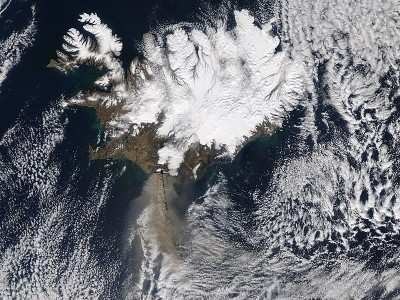Sat, Apr 24, 2010
SAIB Published With Guidelines, But Does Not Recommend Flight
Into Visible Ash
 The FAA this week published an SAIB (Special Airworthiness
Information Bulletin) addressing concerns about the operation of
aircraft with turbine engines into areas where volcanic ash is
present. The SAIB is specifically directed toward operators that
operate in Europe or operate in and out of Europe, while the
Icelandic volcano, Mount Eyjafjallajokull, is still active.
The FAA this week published an SAIB (Special Airworthiness
Information Bulletin) addressing concerns about the operation of
aircraft with turbine engines into areas where volcanic ash is
present. The SAIB is specifically directed toward operators that
operate in Europe or operate in and out of Europe, while the
Icelandic volcano, Mount Eyjafjallajokull, is still active.
After Mount Eyjafjallajokull ended almost 200 years of dormancy
with an eruption on March 20, EUROCONTROL shut down airspace
throughout various airports in Europe as a result of the drifting
volcanic ash cloud from the eruption On April 14. Since that
initial shutdown, the UK CAA has led a coordinated effort that
included the FAA. The effort identified an acceptable level of
dissipating ash concentration which has subsequently allowed
EUROCONTROL to allow flights to resume in most regions.
Volcanic ash can pose a significant threat to aviation safety.
During the 1980s, a number of flights into volcanic ash clouds
occurred that resulted in the simultaneous shutdown of all engines.
Volcanic ash can present short-term as well as long-term
operational hazards to turbine engines. While the shortterm affects
of erosion and power loss are well documented, the long-term
effects of repeated exposures are not well understood.
The SAIB provides information and recommends that operators
follow all new and existing Maintenance and Operational
Instructions from the respective aircraft and engine manufacturers
(Type Certificate Holders) including any recommended post-flight
checks on aircraft that might have flown through airspace
contaminated with volcanic ash. The European Aviation Safety Agency
(EASA) is issuing a Safety Information Bulletin on operations in
and around volcanic ash.

Before flying from the United States to Europe or within Europe,
aircraft owners and operators should review the following
recommendations:
- Although the FAA does not recommend engine operation or flight
into a visible volcanic ash cloud, we do recommend that you obtain
definitive information on operational limitations around ash
clouds, if any, from each of the European National Authority of the
State(s), of which you plan flight operations.
- Follow all aircraft and engine manufacturer’s operating
and maintenance instructions pertaining to operations in airspace
where volcanic ash may be near or present.
- Report any inadvertent encounter with volcanic ash or relevant
findings, including abnormal engine behavior, to the respective
type certificate holders of the aircraft and engines.
More News
Also: Vertical Flight Society, NBAA Maintenance Conference, GA Honored, AMT Scholarship For the first time, students from Embry-Riddle’s Daytona Beach, Florida, campus took t>[...]
Hazardous Weather Information Summary of significant meteorological information (SIGMET/WS), convective significant meteorological information (convective SIGMET/WST), urgent pilot>[...]
"The need for innovation at speed and scale is greater than ever. The X-62A VISTA is a crucial platform in our efforts to develop, test and integrate AI, as well as to establish AI>[...]
(FAA) Inspector Observed That Both Fuel Tanks Were Intact And That Only A Minimal Amount Of Fuel Remained In Each Analysis: According to the pilot, approximately 8 miles from the d>[...]
“Pyka’s Pelican Cargo is unlike any other UAS solution on the market for contested logistics. We assessed a number of leading capabilities and concluded that the Pelica>[...]
 Airborne-Flight Training 05.09.24: ERAU at AIAA, LIFT Diamond Buy, Epic A&P
Airborne-Flight Training 05.09.24: ERAU at AIAA, LIFT Diamond Buy, Epic A&P ANN's Daily Aero-Term (05.07.24): Hazardous Weather Information
ANN's Daily Aero-Term (05.07.24): Hazardous Weather Information Aero-News: Quote of the Day (05.07.24)
Aero-News: Quote of the Day (05.07.24) NTSB Final Report: Cessna 150
NTSB Final Report: Cessna 150 Aero-News: Quote of the Day (05.08.24)
Aero-News: Quote of the Day (05.08.24)




